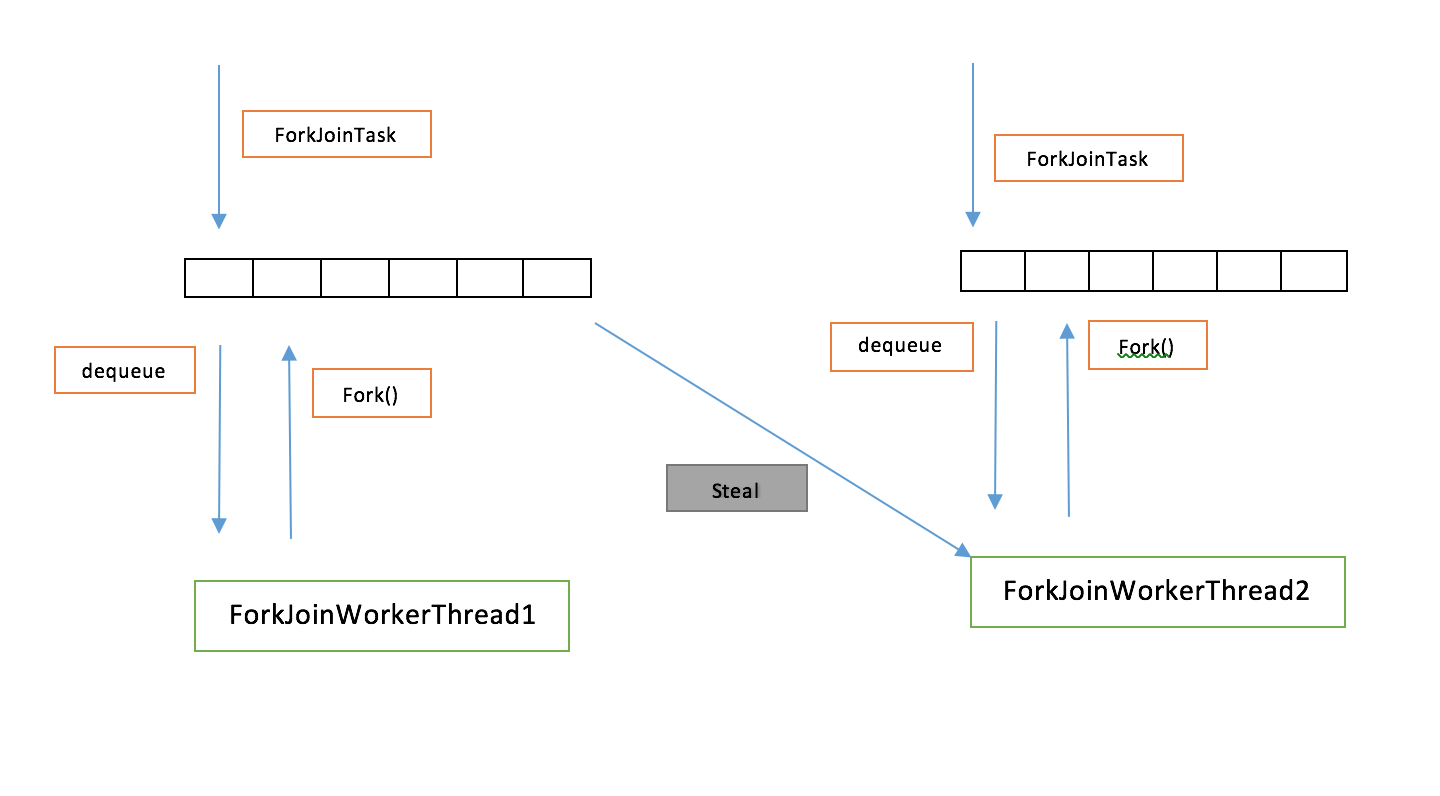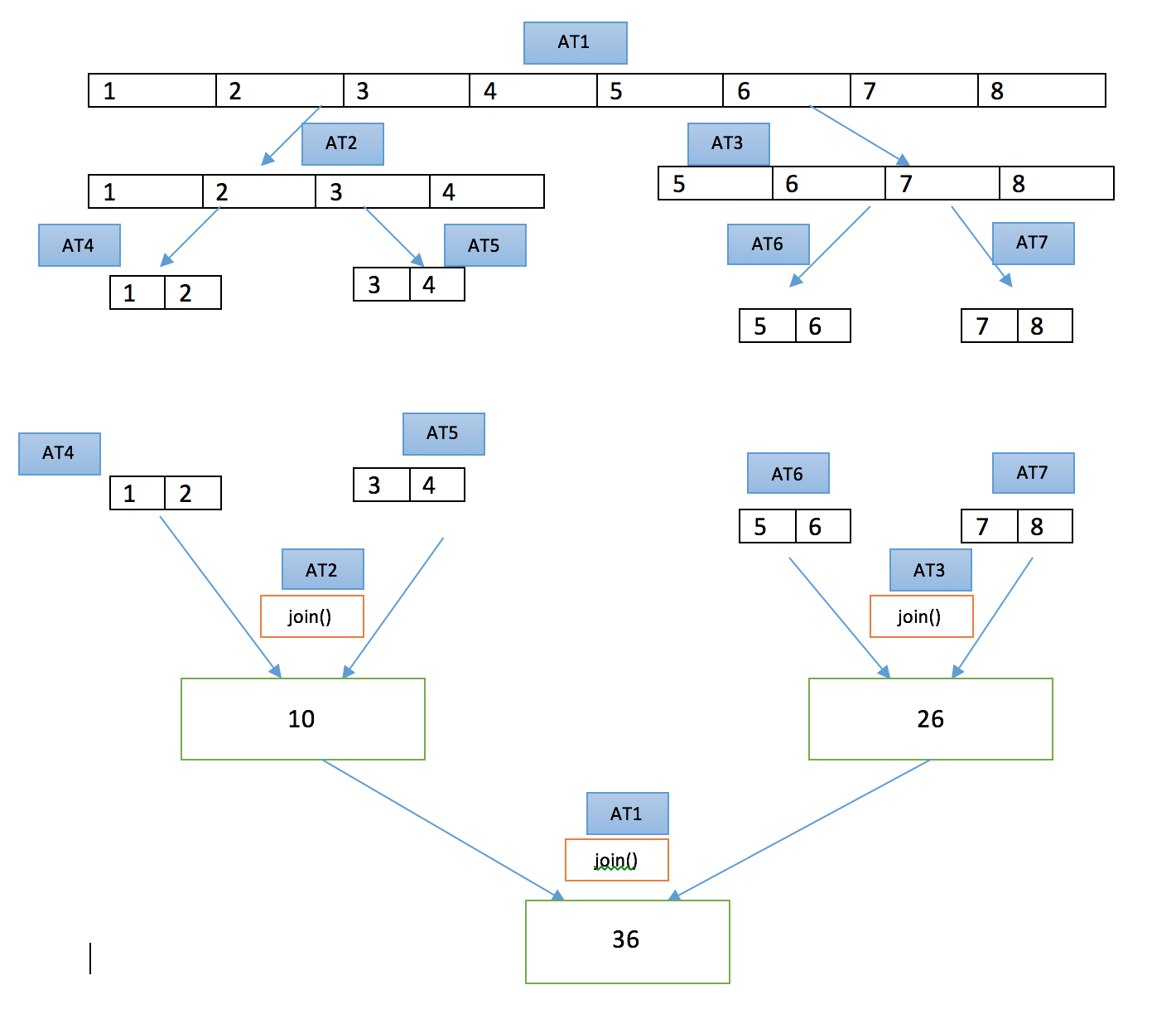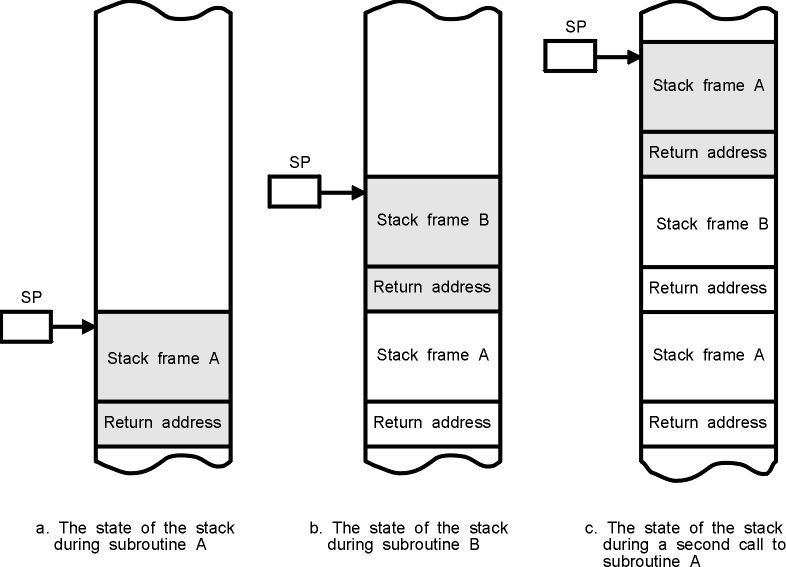ForkJoinThreds,ForkJoinTasks,ForkJoinPool
History
One of the best to ways understand how something works is to start with why that was build in the first place. This gives a very strong foundation for getting the intuition of how it works. Before we get into the details of how ForkJoinThreads work, lets try to build a story of why that was build in the first place.
Lets take an example of adding all the elements of the array, I mean a really large array say 100000 elements.
Note that the goal is not to build an optimised solution fo adding numbers but to get the intuition of the forkjoin concept.
Solution1 : Iterative Solution
A simple way of adding all the elements of the array is by iterating the array elements and adding one after the other.
public class Iter {
public void invoke() {
ArrayList<Integer> list = new ArrayList<>();
int i = 0;
while (i < 10) {
list.add(i);
i++;
}
long stime = new Date().getTime();
System.out.println("Start Time = " + stime);
Integer sum = 0;
i = 0;
while (i < 10) {
sum += list.get(i);
i++;
}
long etime = new Date().getTime();
System.out.println("SUM = " + sum + "\nEnd Time=" + etime);
System.out.println("TotalTime taken = " + (etime - stime));
}
public static void main(String[] args) {
Iter iter = new Iter();
iter.invoke();
}
}An other way of solving this is by recursive appproach using divide and conquer technique.
initialise array with 100000 elements
THRESHOLD=5000 (The smallest unit of work that can be solved and result can be returned)
function int add(startIndex,endIndex)
int sum = 0;
if ((endIndex - startIndex) <= THRESHOLD) {
System.out.println("Computing Sum = " + sum);
while (startIndex <= endIndex) {
sum += array[startIndex++];
}
}
else {
int div = (startIndex + endIndex) / 2;
sum+=add(startIndex, div);
sum+=add(div + 1, endIndex);
}
return sum;
}
endIs this recursive approach efficient than the iterative one? The answer is unfortunately no. Yes its cool to write recursive functions! Unfortunately the above method is still single threaded and does not include any parallelism.
Solution2: Adding a bit of parallelism
Lets say we have a pool of threads maintained by executorservice and a queue attached to add jobs and the executor service takes care of managing the threads (Sorry folks about the java terminologies.Please relate those to any programming languages you are aware of). For the sake of arguement lets assume that there is a way of returning values to the calling thread(Callables and Futures in java).But the calling thread has to wait untill the new thread finishes its job and returns the value.
public class ExecutorServiceTest2 {
public void invoke() {
ArrayList<Integer> list = new ArrayList<>();
final ExecutorService executor = Executors.newFixedThreadPool(10);
int i = 0;
while (i < 10) {
list.add(i);
i++;
}
class AddTask implements Callable<Integer> {
int THRESHOLD = 2;
int startIndex;
int endIndex;
int sum = 0;
public AddTask(int start, int end) {
this.startIndex = start;
this.endIndex = end;
}
@Override
public Integer call() {
if ((endIndex - startIndex) <= THRESHOLD) {
System.out.println("Computing Sum = " + sum);
while (startIndex <= endIndex) {
sum += list.get(startIndex++);
}
}
else {
int div = (startIndex + endIndex) / 2;
AddTask firstHalf = new AddTask(startIndex, div);
AddTask secondHalf = new AddTask(div + 1, endIndex);
Future<Integer> future1 = executor.submit(firstHalf);
Future<Integer> future2 = executor.submit(secondHalf);
try {
sum += future1.get();
sum += future2.get();
}
catch (InterruptedException | ExecutionException e) {
e.printStackTrace();
}
}
System.out.println("Returning Sum = " + sum);
return Integer.valueOf(sum);
}
}
System.out.println("Starting Runnable Test");
Future<Integer> future = executor.submit(new AddTask(0, list.size() - 1));
try {
Integer sum = future.get();
System.out.println("SUM = " + sum);
}
catch (InterruptedException | ExecutionException e) {
e.printStackTrace();
}
}
public static void main(String[] args) {
System.out.println("Starting Main");
ExecutorServiceTest2 executorTest = new ExecutorServiceTest2();
executorTest.invoke();
}
}Note that the executor service had enough threads in its pool to add 10 elements.If you just increase the array size to 1000 or reduce the thread pool size to 2, Then all the threads in the pool are waiting and we end up in thread starvation.There are no threads in the pool to take up new tasks from the queue.One solution is to have as many threads to take up new tasks from the queue.But this would not scale with increasing array size.</p>
We wish the threads which are waiting for the result pause its current job state and start picking up new tasks and later come back and continue from the point where they had paused the tasks before.
Welcome the FORKJOINTHREDS
The above solution had 2 main issues.First, Huge number of threads are created.Second,for problems where there is a dependency among tasks,as the number of tasks increase so as the number of threads required.Lets look at the following approach where fork join threads are used.
public class ForkJoinTest {
public void invoke() {
ArrayList<Integer> list = new ArrayList<>();
int i = 0;
while (i < 10) {
list.add(i);
i++;
}
class AddTask extends RecursiveTask<Integer> {
int THRESHOLD = 2;
int startIndex;
int endIndex;
int sum = 0;
public AddTask(int start, int end) {
this.startIndex = start;
this.endIndex = end;
}
@Override
protected Integer compute() {
if ((endIndex - startIndex) <= THRESHOLD) {
System.out.println("Computing Sum = " + sum);
while (startIndex != endIndex) {
sum += list.get(startIndex++);
}
}
else {
int div = (startIndex + endIndex) / 2;
AddTask firstHalf = new AddTask(startIndex, div);
AddTask secondHalf = new AddTask(div + 1, endIndex);
System.out.println("Creating Task firstHalf:: " + firstHalf.startIndex + firstHalf.endIndex);
System.out.println("Creating Task secondHalf:: " + secondHalf.startIndex + secondHalf.endIndex);
firstHalf.fork();
secondHalf.fork();
sum += firstHalf.join();
sum += secondHalf.join();
}
System.out.println("Returning Sum = " + sum);
return Integer.valueOf(sum);
}
}
final ForkJoinPool pool = new ForkJoinPool(1);
try {
System.out.println("Starting ForkJoin Test");
Integer sum = pool.invoke(new AddTask(0, list.size() - 1));
System.out.println("SUM = " + sum);
}
finally {
pool.shutdown();
}
}
public static void main(String[] args) {
System.out.println("Starting Main");
ForkJoinTest forkJoinTest = new ForkJoinTest();
forkJoinTest.invoke();
}
}The idea here is to divide the array and fork new tasks untill the THRESHOLD is reached. On reaching the THRESHOLD return the result, and start joining results up the way untill the final sum is calculated. The previous Executorservice also did the same thing. The difference is that in the previous method, when a thread called get on the future (sum += future1.get();) the thread was blocked untill the result was returned by the future.That meant the calling thread cannot take new tasks in the executor pool. This is where forkjoin pool shines.
Before we dive into the way the above example works.Lets try to understand the algorithm behind the forkjoinpool.
Stealing ain’t bad: WorkSteal
With ForkJoin there are three main terminologies.ForkJoinTask,ForkJoinPool and ForkJoinWorkerThread. ForkJoinPool maintains a pool of ForkJoinThreads. ForkJoinTasks are like Runnables/Callables. The forkJoinThreads are the entities that are scheduled to run on CPU. Every ForkJoinWorkerThread has its own queue to which ForkJoinTask are added as shown below.

1. When a ForkJoinTask is added to the queue, the ForkJoinTask is dequeued from the head of the queue and the ForkJoinWorkerThread starts executing the ForkJoinTask. 2. If the current ForkJoinTask in execution forks [firstHalf.fork() and secondHalf.fork()], new ForkJoinTasks are added to the same workers queue and the ForkJoinWorkerThread continues its execution.On completing the execution it can pick new tasks from its queue. 3. These new tasks in the queue can be picked up by the other ForkJoinWorkerThread from the back of the queue and start execution.This is called the worksteal approach.Stealing from the back of the queue simplifies the problem of mutiple threads trying to dequeue from the same end.
Still not Impresssed!!! Welcome The awesomeness of join()
The traditional implementation of join causes the current thread to wait untill it is notified. Similar situation happened when future.get() was called in the executor solution, the calling thread was blocked untill get() returned.
The new cool implementation of join() in ForkJoinWorkerThread solves this in a clever way.
1. If there are new tasks in the queue, then it will not wait but instead it dequeues a task and start the execution. 2. If there are no tasks in its queue or in its neighbours queue,then the ForkJoinWorkerThread will wait untill the corresponding task is done on which join was called.
The question to be asked is how does the thread which calls join(), get the results from the corresponding task on which join was called (sum += firstHalf.join();) without getting blocked.
In the above array elements sum problem, we had used the divide and conquer technique. Start by dividing the problem to the smallest possible subproblem[THRESHOLD], then compute the sum and return the sum. This goes up the chain untill the final sum of array is computed.

Its important to note that as and when new subtasks(ForkJoinTasks) are forked, It is possible that the other ForkJoinWorkerThread in the pool can steal these tasks and start execution.
1. How does the current ForkJoinWorkerThread join the result from the task which is executed by other ForkJoinWorkerThread?
2. Also the current ForkJoinWorkerThread picks up new tasks from its queue or from neighbours queues if there are any.For the same problem above lets take a scenario where there are 2 forkjoinworkerthreads in pool.Lets analyse the queue state as and when addtasks are created, added and stolen.

When executing AT1, two taks AT2 and AT3 was forked and join was called on AT2 and AT3.AT2 is again picked by forkjoinworkerthread1 and AT3 was stolen by forkjoinworkerthread2.The point to be noted here is AT2 getting picked by forkjoinworkerthread1 eventhough AT1 is not completed and is waiting for results from AT2 and AT3.
Q&A What happens when join is called on the ForkJoinTask?
Unlike join() of normal java threads which blocks the calling thread untill it is notified, Join() in ForkJoinWorkerThread is a bit different. The forkJoinWorkerthread checks if the current task is completed. If not tries to remove and execute the task from the workqueue.If you look for doJoin() in ForkJointask,awaitJoin() in forkjoinpool and tryRemoveAndExec() functions of workqueue class you would get a better understanding of how this works.
To answer the question of how new tasks are picked up eventhough the current task is not completed and later continue from where it had left off, The important thing to notice is that the way the previous unfinished task state is preserved while taking the new tasks from the queue is by callstack.Just recall how function call is handled. when a function is called first return address is stored and then the stack frame (which included the registry state, variables and object state inside that function).

How does the current ForkJoinWorkerThread join the result from the task which is executed by other ForkJoinWorkerThread?
There is a isdone() method in ForkJoinTask which checks if the task is complete. So when join() is called the join function checks if the task is done , if it is then return the result.
Stats
Iterator:
Elements::10000 TimeTaken::3
Elements::100000 TimeTaken::5
Elements::1000000 TimeTaken::7
ForkJoin:
THRESHOLD = 2;
Elements::10000 TimeTaken::10 Threads::2
Elements::10000 TimeTaken::9 Threads::4
Elements::10000 TimeTaken::10 Threads::8
Elements::100000 TimeTaken::33 Threads::2
Elements::100000 TimeTaken::33 Threads::4
Elements::100000 TimeTaken::27 Threads::8
Elements::1000000 TimeTaken::300 Threads::2
Elements::1000000 TimeTaken::278 Threads::4
Elements::1000000 TimeTaken::268 Threads::8
THRESHOLD = 1000;
Elements::10000 TimeTaken::3 Threads::2
Elements::10000 TimeTaken::4 Threads::4
Elements::10000 TimeTaken::4 Threads::8
Elements::100000 TimeTaken::9 Threads::2
Elements::100000 TimeTaken::9 Threads::4
Elements::100000 TimeTaken::9 Threads::8
Elements::1000000 TimeTaken::25 Threads::2
Elements::1000000 TimeTaken::35 Threads::4
Elements::1000000 TimeTaken::55 Threads::8
THRESHOLD = 10000;
Elements::10000 TimeTaken::3 Threads::2
Elements::10000 TimeTaken::3 Threads::4
Elements::10000 TimeTaken::3 Threads::8
Elements::100000 TimeTaken::7 Threads::2
Elements::100000 TimeTaken::7 Threads::4
Elements::100000 TimeTaken::8 Threads::8
Elements::1000000 TimeTaken::27 Threads::2
Elements::1000000 TimeTaken::34 Threads::4
Elements::1000000 TimeTaken::40 Threads::8After all the Rant, we realise that iterator is faster than other methods :) As I already mentioned the goal was to get the intuition of how forkjointhreads work rather than finding an optimal solution to add array elements.But the above stats teach a very important lesson
“Not always using multiple Threads increase the performance.Use Threads Wisely and With more Threads comes More Responsibility”